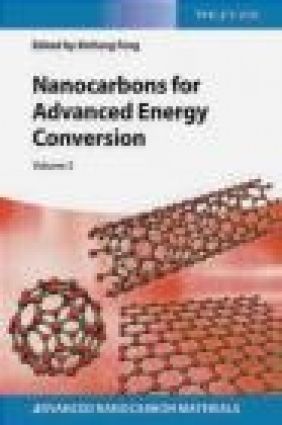Nanocarbons for Advanced Energy Conversion
Nanocarbons for Advanced Energy Conversion
- Producent: VCH
- Rok produkcji: 2015
- ISBN: 9783527336661
- Ilość stron: 326
- Oprawa: Twarda
Niedostępna
Opis: Nanocarbons for Advanced Energy Conversion
In this second volume in the first book series on nanocarbons for advanced applications the highly renowned series and volume editor has put together a top author team of internationally acclaimed experts on carbon materials. Divided into three major parts, this reference provides a current overview of the design, synthesis, and characterization of nanocarbons, such as carbon nanotubes, fullerenes, graphenes, and porous carbons for energy conversion applications. It covers such varied topics as electrocatalysts for oxygen reduction reactions in the different types of fuel cells, metal-air batteries and electrode materials for photovoltaic devices, as well as photocatalysts, electrocatalysts and photoelectrocatalysts for water splitting. Throughout, the authors highlight the unique aspects of nanocarbon materials in these fields, with a particular focus on the physico-chemical properties which lead to enhanced device performances.List of Contributors XI Preface XV 1 Heteroatom-Doped Carbon Nanotubes as Advanced Electrocatalysts for Oxygen Reduction Reaction 1 Jintao Zhang, Sheng Zhang, Quanbin Dai, Qiuhong Zhang, and Liming Dai 1.1 Introduction 1 1.2 Experimental Evaluation of Electrocatalytic Activity toward ORR 2 1.3 Doped Carbon Nanotubes for ORR 4 1.3.1 Carbon Nanotubes Doped with Nitrogen 4 1.3.2 Carbon Nanotubes Doped with Heteroatoms Other Than Nitrogen 8 1.4 Conclusions 13 Acknowledgments 14 References 14 2 Doped Graphene as Electrocatalysts for Oxygen Reduction Reaction 17 Dongsheng Geng and Xueliang Sun 2.1 Introduction 17 2.2 Active Sites and Mechanisms of ORR on Doped Graphene 18 2.2.1 ORR Mechanism on Doped Graphene 18 2.2.2 The Active Site of DopedGraphene forORR 20 2.3 Synthesis and Performance of Doped Graphene 22 2.3.1 Nitrogen-Doped Graphene 23 2.3.2 Synthesis and Performance of Other Heteroatom-Doped Graphene 30 2.3.2.1 B-Doped Graphene 30 2.3.2.2 S-Doped Graphene 31 2.3.2.3 P and Other Heteroatom-Doped Graphene 33 2.4 Conclusions and Perspective 35 References 37 3 Heteroatom-Doped Nanoporous Carbon for Electrocatalysis 43 Sheng Chen, Jian Liu, and Shi-Zhang Qiao 3.1 Introduction 43 3.2 Synthesis of Doped Nanoporous Carbons 45 3.2.1 Synthesis of Heteroatom-Doped Ordered Mesoporous Carbons 45 3.2.1.1 Self-Assembling of Heteroatom-Rich Carbon Precursors through a Soft-Templating Method 45 3.2.1.2 Posttreatment of Ordered Mesoporous Carbon Framework with Heteroatom-Rich Chemicals 47 3.2.1.3 Hard-Templating Method with One-Step Doping Using Heteroatom-Rich Carbon Precursors 49 3.2.2 Synthesis of Doped Porous Graphene 51 3.2.2.1 Vapor-Assisted Method 51 3.2.2.2 Liquid-Phase Method 53 3.3 Heteroatom-Doped Nanoporous Carbons for Electrocatalysis 55 3.3.1 Oxygen Reduction Reaction (ORR) 55 3.3.2 Doped Ordered Mesoporous Carbon for ORR 57 3.3.3 Doped Graphene for ORR 61 3.3.3.1 Single Heteroatom-Doped Graphene 61 3.3.3.2 Dual-Doped Graphene 62 3.3.3.3 Doped Graphene-Based Nanocomposites 63 3.3.4 Other Electrochemical Systems 67 3.4 Summary and Perspectives 69 References 70 4 Nanocarbon-Based Nonprecious-Metal Electrocatalysts for Oxygen Reduction in Various Electrolytes 75 Qing Li and GangWu 4.1 Introduction 75 4.2 Oxygen Reduction in Acidic Media 77 4.2.1 Heat-Treated Macrocyclic Compounds 78 4.2.2 Heat-Treated Nonmacrocyclic Catalysts 78 4.2.2.1 Nitrogen Precursors 79 4.2.2.2 Type of Transition Metals 83 4.2.2.3 Effect of Supports 87 4.2.2.4 Heating Temperatures 89 4.2.3 Importance of in situ Formed Graphitic Nanocarbons 92 4.3 Oxygen Reduction in Alkaline Media 94 4.3.1 Metal-Free Carbon Catalysts 95 4.3.1.1 Nitrogen-Doped Carbon 96 4.3.1.2 Boron and Sulfur Doping 98 4.3.1.3 Binary and Ternary Dopants 99 4.3.2 Heat-Treated M-N-C (M: Fe, Co) Catalysts 100 4.3.3 Nanocarbon/Transition Metal Compound Hybrids 103 4.4 Oxygen Reduction in Nonaqueous Li-O2 Batteries 105 4.5 Summary and Perspective 110 Acknowledgments 111 References 111 5 Spectroscopic Analysis of Nanocarbon-Based non-precious Metal Catalyst for ORR 117 Ulrike I. Kramm 5.1 Introduction 117 5.2 Raman Spectroscopy 119 5.2.1 Theory 119 5.2.2 Characterization of Me N C Catalysts by Raman Spectroscopy 120 5.3 X-Band Electron Paramagnetic Resonance (EPR) Spectroscopy 122 5.3.1 Theory 122 5.3.2 Examples of EPR Spectroscopy in the Characterization of Me N C 124 5.4 X-ray-Induced Photoelectron Spectroscopy (XPS) 125 5.4.1 Theory 125 5.4.2 Example of Postmortem Analysis ofMe N C Catalysts by XPS 127 5.5 Mossbauer Spectroscopy (MBS) 129 5.5.1 Theory 129 5.5.2 Effect of Iron Carbide Formation on the Concentration of Active Sites 132 5.5.3 Influence of the Electronic Structure: Correlation of Isomer Shift and TOF 133 5.6 X-ray Absorption Spectroscopy (XANES/EXAFS) of Metal Edges 134 5.6.1 Theory 134 5.6.2 Influence of Preparation Parameters on the Next Neighbors (EXAFS) 135 5.6.3 Influence of the Pyrolysis Temperature on the Structure (XANES) 136 5.6.4 Correlation between XANES and Mossbauer Results 137 5.7 Possibilities to Do in situ Measurements (Coupled with an Electrochemical Cell/FC) 138 5.7.1 In situ XANES Spectroelectrochemistry on PANI Fe C Catalysts 138 5.8 Outlook 140 References 140 6 Graphene as a Support for ORR Electrocatalysts 149 Ermete Antolini 6.1 Introduction 149 6.2 Synthesis and Structural Characteristics of GNS-Supported Catalyst Nanoparticles (Me/GNS, Me = Mono or Bimetallic Catalysts) 150 6.3 Electrochemical Properties of Me Catalysts Supported on GNS-, Modified GNS-, and Hybrid GNS-Containing Materials 152 6.3.1 Electrocatalytic Activity of Me/GNS for Oxygen Reduction 154 6.3.2 Me Supported on Modified GNS 154 6.3.2.1 Functionalized Graphene byThermal Exfoliation 154 6.3.2.2 Sulfonated Graphene 158 6.3.2.3 Nitrogen-Doped Graphene 158 6.3.2.4 Noncovalent Functionalized Graphene: PDDA-GNS, CTAB-GNS, and gds-DNA/rGO 162 6.3.3 Me Supported on Hybrid GNS-CB, GNS-CNT, and GNS-MeO2 Materials 165 6.3.3.1 Me Supported on Hybrid GNS-CB 165 6.3.3.2 Me Supported on Hybrid GNS-CNT 167 6.3.3.3 Me Supported on GNS-MeO2 Materials 168 6.4 Synthesis and Electrochemical Properties of Nanostructured Me Catalysts Supported on GNS 170 6.5 Conclusions 171 References 172 7 Nanocarbons and Their Hybrids as Electrocatalysts for Metal-Air Batteries 177 Hadis Zarrin and Zhongwei Chen 7.1 Introduction 177 7.2 Nanocarbons 179 7.2.1 1D Carbon Nanomaterial 180 7.2.2 2D Carbon Nanomaterial 180 7.3 Nanocarbonaceous Electrocatalysts for Metal-Air Batteries 181 7.3.1 Metal-Free Nanocarbon Catalysts 181 7.3.2 Noble Metal-Nanocarbon Catalysts 187 7.3.3 Metal Oxide-Nanocarbon Catalysts 191 7.3.3.1 Mono-Metal Oxides 191 7.3.3.2 Mixed Metal Oxides 199 7.4 Conclusions and Future Perspectives 207 Acknowledgments 208 References 208 8 Nanocarbon-Based Hybrids as Cathode Electrocatalysts for Microbial Fuel Cells 215 ZhenhaiWen, Suqin Ci, and Junhong Chen 8.1 Introduction to MFCs and MFC Cathodes 215 8.2 Nanocarbon-Supported Platinum Cathode Catalysts 217 8.3 Nanocarbon-Supported Precious-Metal-Free Cathode Catalysts 218 8.3.1 Transition Metal Macrocycles 218 8.3.2 Metal Oxide 221 8.3.3 Metal-Free Nanocarbon-Based Catalysts 222 8.3.4 Transition Metal-Containing Nanocarbon-Based Catalysts 225 8.4 Conclusions and Outlook 229 References 229 9 Carbon Nanotubes and Graphene for Silicon-Based Solar Cells 233 Xiao Li,Miao Zhu, Dan Xie, KunlinWang, Anyuan Cao, JinquanWei, DehaiWu, and Hongwei Zhu 9.1 Introduction 233 9.2 Carbon/Semiconductor Schottky Junction 234 9.3 Nanocarbon/Silicon Heterojunction Solar Cells 235 9.3.1 Theoretical Model 235 9.3.2 Chemical Doping 237 9.3.3 Antireflection Optimization 241 9.3.4 Hybrid Heterojunction and Photoelectrochemistry Solar Cells 242 9.3.5 Photodetectors 244 9.4 Summary 245 References 246 10 Graphene as Transparent Electrodes for Solar Cells 249 Khaled Parvez, Rongjin Li, and KlausMullen 10.1 Introduction 249 10.2 Production of Graphene 250 10.2.1 Micromechanical Cleavage 251 10.2.2 Liquid-Phase Exfoliation 251 10.2.3 Chemical Vapor Deposition 252 10.2.4 Graphene from Graphite Oxide 253 10.3 Optoelectronic Properties of Graphene 254 10.4 Transparent Conductive Films from Graphene 257 10.5 Organic Solar Cells 262 10.6 Hybrid Solar Cells 268 10.7 Dye-Sensitized Solar Cells 268 10.8 Summary and Future Perspectives 274 References 275 11 Nanostructured Carbon Nitrides for PhotocatalyticWater Splitting 281 Yun Zheng, Lihua Lin, and XinchenWang 11.1 Introduction 281 11.2 PhotocatalyticWater Splitting 282 11.3 Graphitic Carbon Nitride for PhotocatalyticWater Splitting 284 11.4 Nanostructure Design of Graphitic Carbon Nitride 286 11.4.1 Template-Assisted Method 286 11.4.1.1 Hard-Template Method 286 11.4.1.2 Soft-Template Method 289 11.4.2 Sulfur-Mediated Synthesis 290 11.4.3 Solvothermal Technology 292 11.4.4 Top-Down Strategy 292 11.4.5 Combined Methods 293 11.5 Conclusions and Perspectives 294 Acknowledgments 296 References 296 Index 301
Szczegóły: Nanocarbons for Advanced Energy Conversion
Tytuł: Nanocarbons for Advanced Energy Conversion
Producent: VCH
ISBN: 9783527336661
Rok produkcji: 2015
Ilość stron: 326
Oprawa: Twarda
Waga: 0.83 kg






























